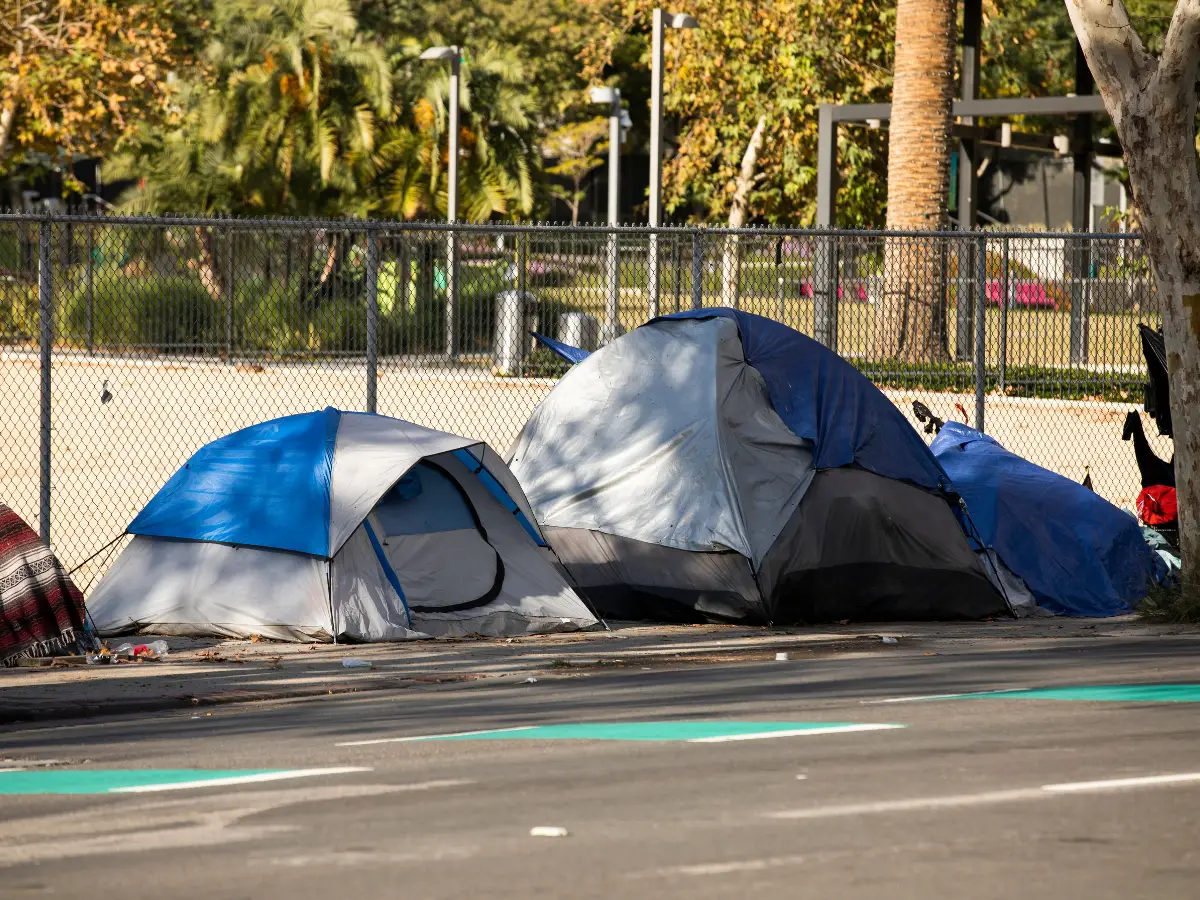California has one of the largest homeless populations in the United States. The state’s homelessness crisis has been a long-standing issue, and despite numerous efforts to address it, the problem persists. According to a U.S. Department of Housing and Urban Development report, California has more than 160,000 homeless people, almost a quarter of the national total.
Many factors contribute to California’s homelessness crisis. One of the main reasons is the state’s high cost of living, which makes it difficult for low-income individuals and families to afford housing.
Additionally, the state’s housing market is incredibly competitive, with a shortage of affordable housing and a high demand for rental properties. This has led to skyrocketing rents and a lack of available housing for those in need.

The Scale of Homelessness in California
California has the largest homeless population in the country, with an estimated 151,278 homeless individuals in 2020, according to the Annual Homeless Assessment Report to Congress. This represents a 16.4% increase in the state’s homeless population since 2019.
The state’s most populous city, Los Angeles, has the largest unsheltered homeless population in the country, with an estimated 41,290 individuals experiencing homelessness in 2020. San Francisco has the second-highest rate of homelessness per capita in the country, with an estimated 8,035 individuals experiencing homelessness in 2020.
While homelessness is a statewide issue, it is concentrated in urban areas. Nearly 70% of California’s homeless population is concentrated in just five counties: Los Angeles, San Diego, Santa Clara, Alameda, and Orange. Los Angeles County alone has an estimated 66,436 homeless individuals, making it the county with the highest number of homeless individuals in the country.
The high cost of housing in California is a major factor contributing to the state’s homelessness crisis. According to a 2019 report by the California Housing Partnership, the state has a shortage of over 1.5 million affordable rental homes for low-income households. This shortage has led to high rents and a lack of affordable housing options, forcing many Californians to choose between paying for housing and other basic needs.
In addition, many homeless Californians struggle with mental illness, substance abuse, and other health issues. According to a 2020 report by the California Policy Lab, over 70% of homeless individuals in Los Angeles County reported having a physical health condition, and over 60% reported having a mental health condition.
Efforts to address California’s homelessness crisis have been ongoing, but progress has been slow. The state has allocated billions of dollars to address homelessness, but many Californians feel that more needs to be done to address the root causes of homelessness and provide affordable housing options for low-income households.

Underlying Causes of Homelessness
Homelessness is a complex issue that has many underlying causes. In California, several factors contribute to the high rates of homelessness, including a housing affordability crisis, income inequality, mental health and substance abuse, and incarceration.
Housing Affordability Crisis
One of the primary causes of homelessness in California is the housing affordability crisis. High rents, chronic housing shortages, and property prices that far exceed the median income have made it difficult for many people to find affordable housing. According to Zillow, the median rent in California is $2,800 per month, which is nearly double the national average. As a result, many people are forced to live on the streets or in their cars.
To address the housing affordability crisis, California needs to streamline and accelerate housing production and reexamine the regulations that have hindered new housing development. Additionally, policymakers need to prioritize the creation of affordable housing units and provide rental assistance to those who need it.
Income Inequality
Income inequality is another significant contributor to homelessness in California. The state has one of the highest poverty rates in the country, with about a third of its 40 million people living in poverty or near-poverty. Sudden illness, an accident, a layoff, or an unexpected car repair bill can easily lead to unpaid rent, eviction, and a lack of shelter.
To address income inequality, California should consider implementing policies that increase the minimum wage, provide more job training programs, and expand access to affordable healthcare.
Mental Health and Substance Abuse
Many people experiencing homelessness in California also struggle with mental health and substance abuse issues. According to a study by UCSF, homelessness often leads to or exacerbates alcohol and drug addiction, as well as mental health conditions like schizophrenia.
To address these issues, California needs to invest in mental health and substance abuse treatment programs and provide more resources to help people with these conditions find housing and employment.
Incarceration and Homelessness
Finally, incarceration is another significant contributor to homelessness in California. Many people who are released from prison or jail have a difficult time finding stable housing and employment, which can lead to homelessness.
To address this issue, California needs to provide more resources to help formerly incarcerated individuals transition back into society. This could include job training programs, affordable housing options, and mental health and substance abuse treatment.
In conclusion, homelessness in California is a complex issue with many underlying causes. Addressing the housing affordability crisis, income inequality, mental health and substance abuse, and incarceration will require a comprehensive approach that involves policymakers, community organizations, and individuals working together to find solutions.

Health Challenges Faced by the Homeless
Homelessness can have a severe impact on an individual’s physical and mental health. Homeless individuals often face significant health challenges due to a lack of access to healthcare, poor living conditions, and exposure to the elements.
According to a report, 151,000 Californians were experiencing homelessness in 2019, and 27% of the total homeless population in the nation were in California. Homelessness in California has increased by 16% between 2018 and 2019.
Homeless individuals are more likely to suffer from chronic illnesses and mental health issues than the general population. Many homeless individuals also have disabilities that make it difficult for them to access healthcare. Access to healthcare is critical for homeless individuals to receive treatment for illnesses and injuries.
Homeless individuals are also at a higher risk of death from various causes, including drug overdoses and exposure to the elements. Substance abuse is a common problem among the homeless population, and drug overdoses are a leading cause of death among homeless individuals.
In summary, homelessness can have a severe impact on an individual’s physical and mental health. Homeless individuals often face significant health challenges due to a lack of access to healthcare, poor living conditions, and exposure to the elements. Homeless individuals are more likely to suffer from chronic illnesses and mental health issues than the general population, and they are also at a higher risk of death from various causes.
California’s Response to Homelessness
California has been grappling with a homelessness crisis for years, with the number of homeless individuals in the state reaching staggering levels. The state has implemented various policies and initiatives to address the issue, but progress has been slow. In this section, we will discuss the government policies and initiatives, as well as non-governmental organizations and services that have been put in place to combat homelessness in California.
Government Policies and Initiatives
Governments at all levels in California have taken steps to address homelessness, but the problem persists. Governor Gavin Newsom declared a state of emergency on homelessness in 2019, which led to the creation of a task force aimed at finding solutions. The task force recommended a range of actions, including increasing funding for housing and services, reducing barriers to housing placements, and improving collaboration between government agencies.
The state has also launched several programs to address homelessness, including Homekey and Roomkey, which provide funding for local governments to acquire and convert hotels and motels into permanent housing for homeless individuals. Additionally, the state has implemented state programs that provide funding for services such as mental health treatment and substance abuse treatment.
Policing has also been a contentious issue in California’s response to homelessness. Some cities have increased policing of homeless encampments, while others have focused on providing services and housing. The effectiveness of policing as a solution to homelessness is a subject of debate, with some advocates arguing that it criminalizes poverty and exacerbates the problem.
Non-Governmental Organizations and Services
Non-governmental organizations and services have also played a critical role in addressing homelessness in California. Many organizations provide shelter, food, and other services to homeless individuals. Some organizations also offer job training and other resources to help homeless individuals transition to stable housing.
One example of a non-governmental organization that has made a significant impact is the Treatment Advocacy Center, which advocates for policies that support individuals with mental illness. The center has worked with the state government to increase funding for mental health services and improve access to treatment for homeless individuals.
In conclusion, California’s response to homelessness has been multifaceted, with government policies and initiatives, as well as non-governmental organizations and services, playing a critical role. While progress has been slow, the state continues to work towards finding solutions to this crisis.
Societal Impact of Homelessness
Homelessness has a significant societal impact, affecting not only the individuals experiencing homelessness but also the communities and society as a whole.
One of the most visible impacts of homelessness is the presence of encampments on the streets, which can create safety concerns and health hazards for both the homeless and the general public. Homelessness also makes vulnerable individuals more susceptible to violence and exploitation, particularly women and children. Domestic violence is also a common cause of homelessness, with many victims forced to leave their homes to escape abuse.
Furthermore, homelessness can strain relationships and families, causing conflict and instability. It can also lead to a cycle of poverty and migration, as individuals move from place to place in search of shelter and resources.
Policies aimed at addressing homelessness must balance accountability with compassion, recognizing that many individuals experiencing homelessness face complex challenges beyond their control. It is important to address the root causes of homelessness, such as high housing costs and inadequate social services, while also providing immediate support and resources to those in need.
In summary, homelessness has a significant impact on society, affecting not only the visible presence of encampments on the streets, but also vulnerable individuals, families, and communities. Addressing homelessness requires a multifaceted approach that balances accountability and compassion and addresses the root causes of homelessness.
Comparative Analysis of Homelessness
California has the largest proportion of homeless people in the United States. According to a 2020 report by the U.S. Department of Housing and Urban Development (HUD), California had an estimated 161,548 homeless people, which is more than any other state. New York and Hawaii come in second and third place, respectively. However, when looking at per capita rates of homelessness, New York and Hawaii have slightly higher rates than California.
A study conducted by William Yu, an economist at UCLA, found that there is a direct correlation between median home values and rents and homelessness rates. California has some of the highest housing costs in the nation, which makes it difficult for low-income residents to afford housing. The COVID-19 pandemic has only exacerbated the issue, as many people have lost their jobs and are struggling to pay rent.
Another contributing factor to California’s homelessness crisis is the lack of progress in addressing the issue. Despite spending billions of dollars, the state has not been able to significantly reduce the number of homeless people. This has led to frustration among voters, who are demanding more action from their elected officials.
Children are also disproportionately affected by homelessness in California. According to a report by the California Homeless Youth Project, there are an estimated 200,000 homeless children in the state. This can have long-lasting effects on their physical and mental health, as well as their education.
While San Jose has made progress in reducing homelessness, other cities in California are struggling to keep up. New York City, for example, has been able to reduce its homeless population by 25% in the past five years. This can be attributed to a combination of increased funding, better coordination between agencies, and a focus on providing permanent housing solutions.
Despite having a surplus in its budget, California’s legislature has been criticized for not doing enough to address the homelessness crisis. Some Republicans have pointed to the state’s liberal policies as a contributing factor, while others argue that more funding and resources are needed to tackle the issue.
Overall, the issue of homelessness in California is complex and multifaceted. While there is no easy solution, it is clear that more needs to be done to address this crisis.
Challenges and Future Prospects
While California has made significant efforts to combat homelessness, the problem persists. The state’s homeless population has increased by 16% between 2018 and 2019, despite the state spending $17.5 billion to address the crisis over four years. Here are some of the challenges and future prospects for addressing the issue of homelessness in California:
Laws and encampments: One of the challenges is the legal framework around homelessness. California has several laws that make it difficult to remove homeless encampments, which can lead to health and safety concerns for both the homeless population and nearby residents. The state has recently passed laws to address this issue, but it remains a challenge.
COVID-19: The COVID-19 pandemic has exacerbated the homelessness crisis in California, as many people have lost their jobs and are unable to pay rent. The state has implemented several measures to address this, such as eviction moratoriums and rental assistance programs.
Housing units: One of the solutions to homelessness is to provide more affordable housing units. California has made efforts to increase the number of affordable housing units, but it has not been enough to keep up with demand.
Camping and crime: Homeless encampments can lead to increased crime in the surrounding areas. This can make it difficult to find solutions to homelessness that are acceptable to both the homeless population and nearby residents.
Drug addiction: Many homeless individuals struggle with drug addiction, which can make it difficult for them to find stable housing and employment. Addressing drug addiction is an important part of addressing the homelessness crisis.
Inequality: California has one of the highest levels of income inequality in the country, which contributes to the homelessness crisis. Addressing inequality is a complex issue that requires systemic change.
UCSF Benioff Homelessness and Housing Initiative: The UCSF Benioff Homelessness and Housing Initiative is a research and policy center that focuses on addressing the homelessness crisis in California. The center works with policymakers, healthcare providers, and community organizations to develop evidence-based solutions to homelessness.
Physician involvement: Physicians can play an important role in addressing the health needs of homeless individuals. The UCSF Benioff Homelessness and Housing Initiative has developed a program to train physicians to provide healthcare to homeless individuals.
Addressing the homelessness crisis in California requires a multifaceted approach that involves addressing legal, economic, and health issues. While there are challenges to finding solutions, there are also promising initiatives and programs that are working towards addressing the issue.
Frequently Asked Questions
What are the main factors contributing to the high homeless population in California?
There are a number of factors contributing to the high homeless population in California. One of the main factors is the state’s high cost of living, particularly when it comes to housing. Many people simply cannot afford to pay rent or a mortgage, and end up on the streets. Additionally, California has a large population of people with mental health and substance abuse issues, which can lead to homelessness.
How has the homelessness crisis in Los Angeles affected the state as a whole?
The homelessness crisis in Los Angeles has had a significant impact on the state as a whole. Los Angeles has the highest number of homeless individuals of any city in the country, and this has put a strain on the city’s resources. Additionally, the homelessness crisis in Los Angeles has drawn national attention to the issue, and has put pressure on state and local officials to take action.
What steps are being taken to address the homelessness problem in California?
There are a number of steps being taken to address the homelessness problem in California. One of the main strategies is to increase funding for homeless services, including housing, healthcare, and mental health services. Additionally, there are efforts to increase the supply of affordable housing, and to provide job training and other resources to help homeless individuals get back on their feet.
What are the long-term consequences of the high homeless population in California?
The high homeless population in California can have a number of long-term consequences. Homelessness can lead to a range of health problems, including mental health issues, substance abuse, and chronic illnesses. Additionally, homelessness can make it difficult for individuals to find and keep a job, which can lead to long-term economic instability.
How do the demographics of California’s homeless population compare to other states?
California’s homeless population is diverse, but there are some trends that are worth noting. For example, California has a higher percentage of homeless individuals who are unsheltered than other states, meaning that they are sleeping on the streets rather than in shelters. Additionally, California has a higher percentage of homeless individuals who are chronically homeless, meaning that they have been homeless for a year or more.
What role do housing affordability and availability play in California’s homelessness crisis?
Housing affordability and availability play a significant role in California’s homelessness crisis. California has some of the highest housing costs in the country, which can make it difficult for individuals and families to find affordable housing. Additionally, there is a shortage of affordable housing in many parts of the state, which can make it difficult for low-income individuals to find a place to live. This can lead to homelessness and housing insecurity.





